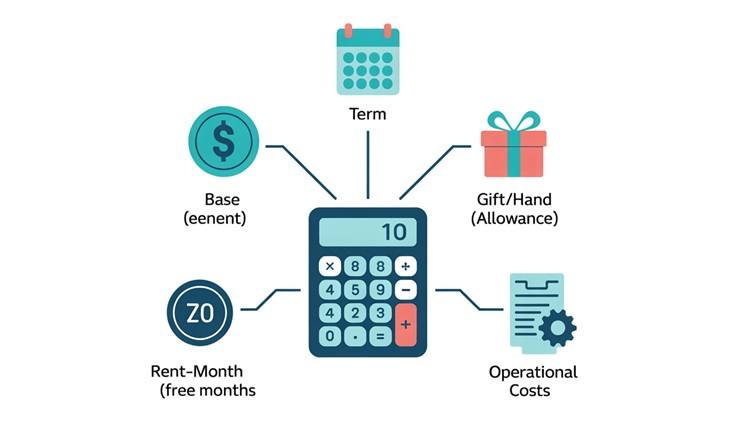Net Effective Rent Calculator
Calculate the true cost of your lease agreement
Calculate Your Net Effective Rent
Enter your lease details below
Your Net Effective Rent
Note: Net effective rent is the average monthly rent after accounting for all concessions and costs. This is an estimate for informational purposes only.
Net Effective Rent Calculator: 2025 Guide, Examples, and Tips

Landlords love to advertise the “net effective rent” because it looks cheaper—especially when they offer free months. Renters need to know the real monthly cost once promos are amortized. This guide explains exactly how our Net Effective Rent Calculator works, how to compare leases with free months and fees, and how to avoid common pitfalls in NYC and other competitive markets. We also cover commercial lease math (TI, free rent, escalations) for an apples‑to‑apples comparison.
Net effective rent (NER) helps you understand the true price of a lease after factoring in concessions (like free months and tenant allowances) and ongoing costs. Use this guide to calculate Net Effective Rent Calculator accurately and compare lease offers apples to apples.
What is net effective Rent (NER)?
Net effective rent is your average monthly cost after spreading any concessions (like free months or credits) and fees over the entire lease term.
- Gross rent: The sticker price (e.g., $3,300/mo).
- Concessions: Free months, rent credits, owner-paid broker fee (OP), move-in credits.
- Fees: Broker fee, amenity/pet/parking fees, utilities if fixed.
- NER: Total paid over the term ÷ number of lease months.
Why it matters: You pay your budget monthly, not just during the promo period. NER lets you compare “2 months free” vs “lower base rent” offers fairly.
Core formulas (residential)
Monthly NER (simple, no escalations)
NER = [BaseRent × LeaseMonths − FreeRentValue − OneTimeCredits + OneTimeFees + (RecurringFees × LeaseMonths)] ÷ LeaseMonths
Where:
- FreeRentValue = BaseRent × FreeMonths (if the promo applies to base rent)
- OneTimeCredits include landlord credits, OP equivalents
- RecurringFees include amenity, pet, parking if monthly
If the concession is “spread” vs “upfront,” the NER is the same; your cash flow timing differs.
Monthly NER with annual escalations (optional)
- If your base rent increases (e.g., 2% after month 12), compute the total you’ll actually pay, then divide by total months. For precision, discount future months:
How to Use the Net Effective Rent Calculator (Step by Step)
- Enter Base Rent (BR)
- What: The advertised monthly rent (e.g., 2,500)
- Tip: Use the pre-concession, pre-discount number.
- Enter Lease Term (Term)
- What: Total months in the lease (e.g., 12, 24, 36)
- Enter Rent-Free Months (N)
- What: Number of months with $0 rent (e.g., 1 or 2)
- Enter Tenant Allowance (TA)
- What: One-time cash allowance or incentive from the landlord (total amount over the lease)
- Example: $1,500 moving credit or tenant improvement allowance
- Enter Operational Costs (OC)
- Option A: Fixed dollar amount per month (e.g., $150)
- Option B: Percentage of monthly rent (e.g., 5% of BR)
- The calculator can convert percentage to dollars automatically:
OC$ = BR × (OC% ÷ 100)
- Choose output view
- Monthly NER or Yearly NER (annualized)
- Review the breakdown
- You’ll see base rent, term, free months, allowance, operational costs, total rent paid, and the effective monthly/annual results.
Net Effective Rent Formula
Primary formula provided:
NER = 12 × [BR × (Term − N) − TA − OC × Term] ÷ Term
Where:
- BR = Base rent per month
- Term = Lease term in months
- N = Rent-free months
- TA = Tenant allowance (total, one-time)
- OC = Operational costs per month (or BR × OC%)
Interpretation:
- The bracket [ … ] is the net “annualized” rent amount normalized by the lease term.
- If you want the monthly NER directly:
Monthly NER = [BR × (Term − N) − TA − (OC × Term)] ÷ Term - Annual NER (12-month normalized) is:
Annual NER = 12 × Monthly NER
Using OC as a percentage:
- OC$ per month = BR × (OC% ÷ 100)
- Then substitute OC$ into the formula.
Important note:
- This guide follows the provided formula which subtracts OC. In some markets, tenants add operating expenses to rent (i.e., OC increases total cost). If you’re calculating a tenant’s total monthly burden and your OC is an added cost, use a plus sign for OC instead of minus.
Gross Rent vs. Net Rent
Gross Rent
- The sticker price (advertised monthly rent)
- Doesn’t account for concessions (free months, allowances) or operating costs
- Easy to compare at a glance, but may be misleading
Net Rent
- Rent after adjusting for concessions and costs
- Shows the true economic value of the lease over time
- Useful for comparing different offers with incentives
Net Effective Rent (NER)
- Average monthly or annual rent after all concessions/costs are considered
- Best metric for apples-to-apples comparisons between leases with different incentives
How to Calculate Effective Rent: A Worked Example
- BR (base rent per month): $3,000
- Term: 12 months
- N (rent-free months): 1 month
- TA (tenant allowance): $2,000 (one-time)
- OC (operational costs): 5% of BR per month
Step 1: Convert OC% to dollars
- OC$ = 3,000 × 0.05 = $150 per month
Step 2: Compute total rent actually paid (after free months)
- BR × (Term − N) = 3,000 × (12 − 1) = 3,000 × 11 = $33,000
Step 3: Compute total OC over the term
- $150 × 12 = $1,800
Step 4: Apply formula
- Monthly NER = [33,000 − 2,000 − 1,800] ÷ 12
- Monthly NER = 29,200 ÷ 12 = $2,433.33
- Annual NER = 12 × 2,433.33 = $29,200
Interpretation:
- Sticker price says $3,000/month, but after factoring in 1 free month, $2,000 allowance, and 5% OC each month, the net effective rent is about $2,433/month.
Scenario B (24-month lease, to show annual normalization)
- BR: $2,400, Term: 24 months, N: 2 months, TA: $3,000, OC: $100/month
Step 1: Total rent paid
- 2,400 × (24 − 2) = 2,400 × 22 = $52,800
Step 2: Total OC
- 100 × 24 = $2,400
Step 3: Monthly and annual NER
- Monthly NER = [52,800 − 3,000 − 2,400] ÷ 24 = 47,400 ÷ 24 = $1,975.00
- Annual NER = 12 × 1,975 = $23,700
- Note: Annual NER is normalized to a 12-month year even though the lease is 24 months.
Commercial lease variant (office/retail)
In commercial real estate, “effective rent” often uses a present-value approach and includes TI (tenant improvement) credits and free rent.
Simplified effective rent per year (no discounting)
EffectiveAnnualRent = [Σ BaseRent_t − TI_allowance − FreeRentValue] ÷ TermYears
PV effective rent per sqft (with escalations)
- Given: Base rent $55/sf/yr, 5‑year term, 6 months free, TI $40/sf paid at start, 3% annual escalation, NNN $12/sf (pass-through), discount rate r = 7%.
- PV of rent stream = Σ [AnnualRent_t] / (1 + r)^t
- PV net of TI = PV_rent − TI
- Effective annual rent (PV) = (PV net of TI) ÷ AnnuityFactor(5 yrs, r)
- Effective monthly or $/sf equivalent: Divide by 12 or by square footage.
Commercial key point: Escalations and TI can swing effective rent more than free months alone. Use PV-based NER for apples-to-apples.
Why NER Matters
- For renters: Know your true monthly cost after incentives and fees.
- For landlords: Price competitively while offering concessions.
- For brokers: Present clear, comparable, and transparent offers.
Common Mistakes to Avoid
- Ignoring rent-free months (overstates cost)
- Forgetting to include tenant allowances (overstates cost)
- Mixing up monthly vs. annual numbers
- Treating percentage operational costs as a flat dollar amount without converting
- Comparing gross rent to net rent without normalizing (apples vs. oranges)
Pro tips to compare leases accurately
- Normalize the term: Always compare on the same number of months (e.g., convert 15‑month offers to 12‑month equivalents if you need a yearly budget).
- Include all fees: Amenity, pet, parking, utilities, insurance, trash—small fees change NER meaningfully.
- Don’t ignore broker fees: Amortize broker or finder’s fees across the term.
- Clarify timing: Is free rent upfront or amortized monthly? Upfront lowers early cash outflow but yields the same NER.
- Watch escalations: A 2–3% step‑up after month 12 can erase the value of an extra free month.
- Read fine print: Some credits don’t apply if you end the lease early or transfer units.
- NYC nuance: “OP” (owner pays broker) is a real concession—treat it like a credit equal to the market broker fee.
Common pitfalls
- Comparing gross to net: Always convert to NER before deciding.
- Ignoring utilities/parking: A $150 monthly parking fee adds 1,800/year( 1,800/year( 150 to monthly NER).
- Falling for teaser ads: Ads might show the NER as if it’s the monthly payment. Your paycheck will see the gross charge most months.
- Not planning for renewal: After the promo, renewals often jump to gross market rent.
Sample comparison table
| Scenario | Base Rent | Free Months | One-Time Fees | Monthly Fees | Term (mo) | NER |
|---|---|---|---|---|---|---|
| A (NYC promo) | $3,200 | 2 | $400 | $75 | 12 | $2,775 |
| B (Lower base) | $3,050 | 1 | $0 | $0 | 12 | $2,537.50 |
| C (Broker fee) | $3,000 | 1 | $3,000 | $0 | 12 | $2,750 |
Quick Tips
- Always compare leases on a net effective basis.
- Normalize to monthly NER (and annual NER if needed) for a clean comparison.
- If OC is a tenant-paid cost added to rent, use a plus sign for OC in your monthly burden calculation.
FAQs/ Frequently Asked Questions
Use Net Effective Rent Calculator to get the true apples-to-apples price of a lease. Enter BR, Term, free months (N), tenant allowance (TA), and operational costs (OC), and compare the monthly/annual NER across different offers to find the best value.
You can know about How to Compare Leases with Free Months and Net Effective Rent vs Gross Rent.

